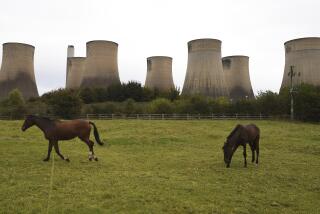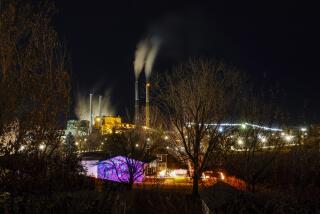Column: Mississippi power plant’s shutdown confirms that ‘clean coal’ as an industry savior is a myth
- Share via
The faith of coal advocates in the doctrine of “clean coal”— technology that would allow utilities to burn coal for electricity without somehow poisoning the environment — has suffered a possibly fatal blow.
Southern Co., which has been building a “clean coal” plant in eastern Mississippi since 2010, has just pulled the plug on the project and is preparing to take a loss of as much as $3.4 billion.
The company and its utility subsidiary Mississippi Power didn’t actually have much choice. The state’s utility regulators, the Public Service Commission, said late last month that they wouldn’t allow the company to charge electricity customers for the plant. They said discussions about what to do with the plant, including whether to convert it to all-natural gas fuel, should begin as soon as Thursday.
Costs began increasing almost immediately, especially once ... the company discovered that many of the original designs needed major changes.
— An MIT report describing the problems of a Mississippi “clean coal” plant
In part, the Public Service Commission decision reflected the plant’s history of design miscalculations, cost overruns and breakdowns. A flagship of the American “clean coal” fleet, the Kemper County plant originally was estimated to cost less than $3 billion.
“But costs began increasing almost immediately,” a survey by Massachusetts Institute of Technology reported, “especially once construction began in 2010 and the company discovered that many of the original designs needed major changes.” The current estimate is $7.5 billion.
“Clean coal” technology involves turning coal into synthetic gas before burning it to produce electricity. The Kemper plant was designed to strip carbon dioxide out of the exhaust and pump it underground so it couldn’t contribute to climate change.
The Obama administration showed great interest in clean coal technology, and it’s a centerpiece of the Trump administration’s promise to save the coal mining industry — a goal that many energy experts consider hopeless.
Expectations for the Kemper plant, which is located next to a mine for lignite, the dirtiest form of coal, always were ambitious; coal gasification never had been used to produce commercial electricity, according to climate experts.
Southern Co. disclosed last month that some of the equipment was leaking and would have to be redesigned and replaced, a process that could take up to two years.
More critically, the entire plant has been shown to be uneconomical. That’s largely because the price of natural gas has remained well below the cost of clean-coal generation.
In a presentation to investors last February, Southern Chairman and CEO Thomas Fanning said the Kemper project was based on an estimate that natural gas prices would be higher than $5 per million BTU, or British thermal units, by 2020 and keep moving higher.
But prices haven’t reached that level since a spike in early 2014; gas currently is listed at about $2.83 on the spot market. Government forecasters don’t expect it to settle above $5 until 2030 at the earliest.
Fanning argued then against charging Southern for the cost of the plant since the main culprit, in his view, was the low price of gas.
“As a matter of fairness, I cannot imagine that the company is going to be held accountable for changing gas price forecasts,” he said. “Just because you have this more recent snapshot of what we believe about the future, which we all know has changed dramatically over time, that does not mean anything about the imprudency of costs incurred.”
Keep up to date with Michael Hiltzik. Follow @hiltzikm on Twitter, see his Facebook page, or email [email protected].
Return to Michael Hiltzik’s blog.
More to Read
Inside the business of entertainment
The Wide Shot brings you news, analysis and insights on everything from streaming wars to production — and what it all means for the future.
You may occasionally receive promotional content from the Los Angeles Times.











